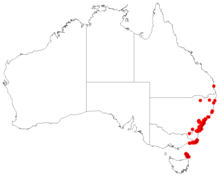Leucopogon esquamatus
Leucopogon esquamatus is a small Australian plant in the family Ericaceae. Growing to 1 metre high, it is commonly seen in open, swampy heath country on sandstone.[1] The specific epithet esquamatus is derived from Latin, meaning "without scales", possibly to distinguish it from other similar plants with scale-like leaves.[2] This is one of the many plants first published by Robert Brown with the type known as "(J.) v.v." , which means that Brown saw it living at Port Jackson. Appearing in his Prodromus Florae Novae Hollandiae et Insulae Van Diemen in 1810.
| Leucopogon esquamatus | |
|---|---|
 | |
| Botany Bay National Park, Australia | |
| Scientific classification | |
| Kingdom: | Plantae |
| Clade: | Tracheophytes |
| Clade: | Angiosperms |
| Clade: | Eudicots |
| Clade: | Asterids |
| Order: | Ericales |
| Family: | Ericaceae |
| Genus: | Leucopogon |
| Species: | L. esquamatus |
| Binomial name | |
| Leucopogon esquamatus | |
 | |
| Occurrence data from AVH | |
References
- Powell, J.M. "Leucopogon esquamatus". Plant Net - Flora Online. NSW Government. Retrieved 21 April 2019.
- Les Robinson – Field Guide to the Native Plants of Sydney, ISBN 978-0-7318-1211-0 page 108
This article is issued from Wikipedia. The text is licensed under Creative Commons - Attribution - Sharealike. Additional terms may apply for the media files.